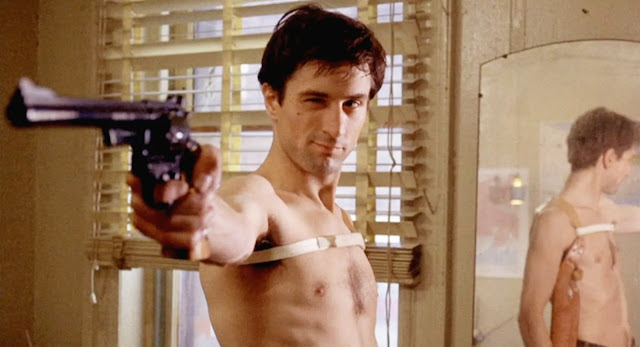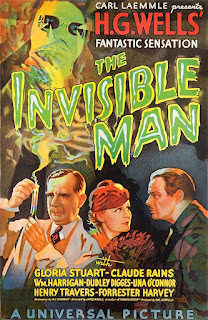Scorsese/De Niro: Taxi Driver (Dir. Martin Scorsese, 1h54m, 1976)
Taxi Driver and De Niro's Travis Bickle became the template of any number of neo-noir vigilantes, from Michael Winner's Death Wish II (1982) and the b-movie trend for revenge thrillers reaching the nadir with I Spit on Your Grave to the senior elements (the rest lifted from King of Comedy, coming next month) of Todd Phillip's Scorsese-aping Joker (2019). This is not to mention the spectre of John Hinkley Jr, who, like many of the film's less savoury fanatics, failed to understand Bickle as a sociopathic racist maniac, rather than a well-intentioned extremist, and attempted to recreate his actions on a colossal, and to Scorsese, mortifying, and near-career-ending, stage. Strip away the ultra-violent imitators, both real and imagined, though, and one is left with De Niro at his early best, giving a unflinching portrait of a man's psychic crisis against the background of a rotting New York.
Between Mean Streets and Taxi Driver, Scorsese had made one film, the underrated romantic drama, Alice Doesn't Live Here Anymore (1974)-an unusual outlier for Scorsese given its female protagonist, and comedic sensibilities. De Niro's star, meanwhile, continued to rapidly rise, picking up a host of awards playing the vengeance-set younger Vito Corleone in The Godfather Part II (1974). Into this duo would come, in the power trio that would make two of Scorsese's best films of the 1970s, writer Paul Schrader. Four years' Scorsese's junior, he'd begun life as a critic, studying under the recommendation of no less than the legendary Pauline Kael, whilst his first script, The Yakuza (1974), with brother Leonard, became the epicentre of a prolonged bidding war.
Whilst the Sidney Pollack-helmed film was a financial disappointment, Schrader had caught the eye of the up-and-coming generation of directors, among them Brian De Palma, for whom he wrote Obsession (1976). With his own insomnia-driven observations-Schrader would write Taxi Driver in a feverish two weeks, so he portrays the deteriorating mental state of the drifting, often misanthropic figure of Vietnam Vet Travis Bickle, a taxi driver working night-shifts, who finds himself-or rather imposes himself, into the life of a political aide, and Iiris, a child controlled by a vicious pimp. Bickle's character-turned down by Dustin Hoffman and Al Pacino before Scorsese turned to De Niro, a composite of the real-life shooter of Presidential candidate, George Wallace, the honourable death-seeking samurai of Japanese cinema, Bresson's Pickpocket (1959), post-Vietnam America, and the crumbling facades of 1970s New York.
 | |
| A man unspooling: Robert De Niro as Travis Bickle |
Taxi Driver begins and ends in the yellow cabs of New York; the opening credits, to Bernard Hermann’s score depicting a taxi slowly emerging from clouds of steam as Hermann’s jazzy brass and snares sets the tone to come-as the great composer's final score, at once threatening, and elagic, loneliness put to a saxophone line. It's some of Hermann's best scores and achieveso does two things. First, it matches great menace, the clattering drums, the warning horns, with these passages of great beauty, and secondly, in doing so, it encapsulates both the city of New York, a place at once beautiful and ugly, falling apart at the seams, and Travis Bickle himself. The taxi is, simply, the conduit between the two elements, and as Schrader has subsequently noted, an externalisation of this sense of isolation, noting, in later interviews that the cab acts as "this person in an iron box, a coffin, floating around the city, but seemingly alone". Bickle is alone.
Yet, we are in the taxi, in the box, with Bickle-De Niro's narration, excerpts from his diary, float between the ravings of a madman, wishes to wipe a rotting New York free of its underbelly, his dark, and unnerving views of the world, his attempts to battle his loneliness, and his macho sensibilities. What is truly an insight into his mindset, into this unspooling man, is the consistent POV shots, with DoP Michael Chapman and his team often sat in the boot or in the footwell of the car to shoot the sequences, often without permission. They capture the unsettling inner workings of Bickle, that threatening edge that Hermann's brass hints at. They capture the eyes, the mind of Travis Bickle, the eye at once roving, paranoid, belieing Bickle's racism, his own ignored weird, and voyeuristic, lingering on women in the street.
 |
| Through the city darkly-the rotting form of New York is a omnious lingering figure throughout the film |
Only occasionally, such as in the case of Betsy (Cybill Shepherd), does this voyeurism
dissipate, to be replaced by something equally unsettling. Bickle of course, plays on surface level, the vigilante, the individual, the small man against the faceless colossal decay. This is how he justifies himself, this is
the role he plays to mirror and camera. This is not what his narration, his POV shots, reveal, and one is left, even before the film's dénouement, questioning the dissonance between the two; there are shots that,
for all their lonely beauty, simply do not add up, Bickle's version of reality, often shot, particularly in the latter sequences, from above or a seemingly impossible second POV intercut with the veracity, with the POV of Bickle. This juxtaposition is more than simply visual; from Bickle's use of pornography, of a cinematic abstraction of the very vices that
he rages against, and ultimately attempts to liberate Iris (Jodie Foster) from, to the fractured sensibility that surrounds Betsy, simultaneously unobtainable and dismissed by Bickle as just part of the 'union of women'.
This
is disturbing enough; despite Bickle's distaste for the 'scum' of New York, he is a contradiction, a man coming apart at the seams, part of the city's decay, but the film juxtaposes these, starkly, with the
almost stereotypical masculinity, Scorsese representing the misanthropic misogyny of the streets, an unsettling visitation in the back of Bickle's cab, the director's worst impulses laid out in this gun-toting maniac
who, like Bickle, is a voyeuristic bystander hiding violent impulses. There may be a macho strut to the infamous "You Talkin' to Me?" scene but there's something pathetic, almost ludicrous about the huge
.44 Magnum and its holster next to the lean figure of Bickle, posing and posturing and acting out the role of a vigilante, just as he will later act the role of would-be-saviour to Iris later
in the film, and will, in the film's final moments, act the role of abashed hero, only for the film's final shots, the final, stark glance in the mirror, to jolt back to the beginning of the film.
 |
| A pastiche of masculinity: Bickle is a fragmented man for a fragmented city. |
Travis
hasn't changed. The rot hasn't abated. New York is still falling to pieces morally and physically. We're going nowhere. We're still in the box. We're still in the taxi. And so is De Niro. And so is Scorsese.
Travis Bickle is as much a symptom of the rotting city as he is its would-be cure, a gun-toting vigilante that is unwinding, like so much film from a camera, into an actor, a performer of ultra-violent acts that he has no
control over. It is De Niro at his best, at his most unnerving, and at his most mercurial, in the most divisive film of Scorsese's early career. Nearly fifty years on, few films are as loaded with such pathos, as much
significance, as Taxi Driver's stark drive through the underbelly of New York in the cab of Travis Bickle.
Rating:
Must See
Taxi Driver is available to stream via Apple TV in the UK and USA, and is available on DVD and BluRay via Universal.
Next week, a change of pace, as De Niro and Scorsese, with Liza Minelli in tow, go Broadway, in New York, New York.
Why not keep up to date with all things AFootandAHalfASecond, or comission a season of your own, and subscribe to my Patreon from just £1/$1.00 (ish) a month? https://www.patreon.com/AFootandAHalfPerSecond



Comments
Post a Comment